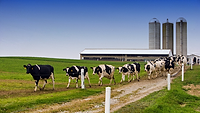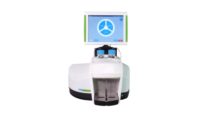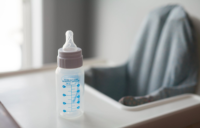ConAgra Dairy Foods: No Substitute for Safety

Egg products manufacturer ConAgra Dairy Foods possesses en viable records of food safety and first-pass quality that result from the “conscientious application of quality systems and proactive reduction of risk.” A commitment to educating both line operators and lab technicians is key to making management’s vision a reality.
As Manager of Quality Assurance with ConAgra Dairy Foods, David Welch has a lot to be proud of. Eggbeaters®, the product for which he oversees quality and food safety, has gone 29 years without a food safety-related incident regarding this product at the St. Louis, MO, facility. The pasteurization and process control technologies employed at this facility are world class. The gleaming stainless steel and spotless production area attest to a rigorous sanitation regimen. The microbiology lab operates with a proficiency few food companies possess in house. The list of accomplishments goes on, but it is the people, the operators on the line who have made a commitment to food safety and quality, who bring Welch the greatest satisfaction.
“You can go up to any person in this plant, some of whom have been here more than 30 years, and they will talk to you about topics such as food microbiology and how what they do day in and day out relates to food safety,” Welch says. “We make a concerted effort to bring all of our people to a level where they understand the business, the product and the significance of everything they do.”
That business is the yearly production of 45.5 million pounds of Eggbeaters brand egg substitute and a recently introduced egg white product. Both of these are offered as refrigerated and frozen products. As their core component is eggs, a long-scrutinized foodstuff whose handling and manufacture fall under both U.S. Food and Drug Administration (FDA) and U.S. Department of Agriculture (USDA) purview, Welch and his colleagues are afforded no margin for cutting corners. Beyond the fundamental assurance of a safe product, the understanding at ConAgra Dairy Foods that safety and quality work in tandem as the cornerstone of customer satisfaction has been the main driver of brand loyalty and thus, the company’s success in the marketplace.
Formerly the Beatrice Food Group, the recently renamed ConAgra Dairy Foods Co. has a portfolio that includes table spreads, whipped toppings and an array of cheeses, in addition to the egg products coming out of St. Louis. ConAgra Dairy Foods Co. is an operating company of ConAgra Foods, Inc., which is North America’s largest foodservice manufacturer and the second largest retail food supplier with annualized sales of $27 billion.
ConAgra Dairy’s SKUs in the refrigerated egg products line include sleeved packages of three four-ounce cups and two eight-ounce gabletops, and a 16-ounce and 32-ounce gabletop pourspout. These are sold in every major retail chain in the country, and enjoy significant penetration in the institutional and club store markets. “We’re driving hard in the refrigerated category, because that’s where we believe the future is,” Welch says.
“Our record of food safety doesn’t just happen,” he says. “We made it happen with our quality systems management strategy,” the essence of which is the “conscientious application of quality systems and the proactive reduction of risk to the absolute lowest level.”
Advanced Intervention, Risk Reduction
A major part of this risk reduction, and the heart of the manufacturing process, is pasteurization. The company incorporates “a proprietary patented technique that enhances the pasteurization process and makes it more effective,” Welch says.
The standard USDA pasteurization achieves the target five-log reduction of microorganisms. “Our process exceeds USDA’s time and temperature requirements for pasteurization,” Welch says. “Temperature, flow and retention times are controlled in a very tight range, very close to where the egg could be cooked in line. We do this because there is an added benefit to doing so.”
The Eggbeaters egg substitute is 99% egg white, with other functional components added to create whippability. Incoming ingredients are checked against their certificates of analysis (COAs) and sensitive items, such as liquid eggs—which already have been pasteurized and come with USDA certification from the vendor—undergo corroborative testing. “We communicate with our suppliers about their performance through a corporate vendor audit and certification program,” Welch says.
The pasteurization process constitutes the control mechanism for the potential microbiological hazards identified in the company’s risk assessment and Hazard Analysis & Critical Control Points (HACCP) plan. Time and temperature are maintained to strict tolerances with a number of on-line automated controls and built-in diverts, which are “backed up by manual verification in every single case,” Welch says. Physical hazards are handled with in-line screens and rare earth magnets, and the primary chemical hazard—residues of sanitizers and cleaning compounds—is addressed by testing at the end of each clean-in-place (CIP) run to assure an adequate flush was achieved.
HACCP is just one component of what Welch considers to be the essential element of quality management: “knowing all there is to know about the product, from the composition of raw materials to the functionalities of the finished product, how it responds to consumer handling and different conditions, and what happens to it way beyond its shelf life.”
Quality Auditing and On-line Testing Essential
Beyond issues of microbiological safety, a concern with any product receiving a significant thermal treatment is the impact on quality and product functionality. For ConAgra Dairy’s egg products, a key indicator is pourability. “Viscosity is the most significant measure in terms of quality,” Welch says. “We want a uniform, homogeneous pour with no signs of coagulation and/or separation,” which would occur as a result of protein denaturation.
Percent solids and pH are also important measurements. “In addition to being a factor contributing to the growth of microorganisms, pH has a lot to do with flow dynamics. Controlling product within a certain pH range provides an even fluid dynamic in the line during the process. This results in minimal friction and greater process efficiency,” Welch says. Microwave moisture analyzers are employed for solids measurements.
The analytical lab is staffed by three technicians who serve largely as auditors; production records are audited at the end of each run and go through three levels of checking before winding up on Welch’s desk for final review. Many quality tests have been transferred to the line, “where the rubber meets the road,” Welch says, “giving us a much greater degree of control than ever before.” Operators who have intimate knowledge of the equipment are guided by concise standard operating procedures (SOPs) governing their operation, maintenance and tests to perform at critical junctures in the process.
Trained sensory panels also are retained to sample cooked product to assure color, flavor, mouthfeel and texture indices are being met. In the event of a quality aberration, the affected product is put on hold and a panel of experts from several disciplines discuss the issue. The ultimate decision as whether to destroy or release the product is made after carefully analyzing all the safety factors and risks.
“We have a good record on first-pass quality which says to me that our people on the floor are controlling their operations the way they need to be controlled,” Welch says.
Emphasizing Analytical Competency
While quality testing potentially can prompt a product hold, product is always held pending microbiological test results. Tests for Salmonella are conducted using the U.S. Food and Drug Administration (FDA) Bacterial Analytical Manual (BAM) methodologies; samples also are analyzed for Staphylococcus aureus and coliforms, with a positive result on the latter prompting further testing to confirm the absence of Escherichia coli.
The microbiology lab currently is staffed with four “extremely competent and capable” microbiologists. “We are always looking for ways to alleviate pressure on the lab and over the past four years we have been able to increase lab output while better utilizing staff,” Welch says, emphasizing that expeditious turnaround of samples in the lab relates directly to more timely shipment of product.
“We guarantee our customers minimal times for product delivery, and we need to maintain minimal inventories because we don’t want shelf life being used up in the warehouse. We need to get samples through the lab as quickly as possible,” he says.
Rapid testing methods have had a significant impact. Two years ago, it took upward of 13 days to get results on the full complement of microbiological tests. The goal this year was to be able to turn around samples within five days, and the lab actually is achieving turnaround times of three to four days. “The limiting factor is Salmonella,” Welch says. “Even when we are able to go to a rapid methodology we will still use cultural methodology for confirmation.”
A number of rapid methods, including enzyme-linked immunosorbent assays (ELISA) and conductance-impedance instrumentation, has been investigated and incorporated, as appropriate. The company currently is working with USDA and several independent laboratories on a comparative study of Salmonella detection using an automated immunochemical detection system. “The instrument already has been established as appropriate for eggs but previous studies did not include liquid egg products, which is what we’re going to assess,” Welch says. The lab participates in an AOAC International proficiency testing program and an internal proficiency program is about ready to go on line.
Welch says one important feather in the company’s hat is that all microbiological and analytical testing is done in house. “We don’t typically outsource any work, and when we do it is for the purpose of achieving a higher degree of confidence in our results,” he says. “In addition to routine testing our lab is really involved in applied research. We put a lot of emphasis on microbiological competence because it is so significant to our product.”
Keeping a Strategic Eye on the Environment
Standard microbiological testing also is conducted to assess the efficacy of the sanitation program and to identify trends in environmental conditions. In terms of environmental monitoring, he adds, “We have explored ATP bioluminescence. When used strictly as an indicator of cleaning effectiveness it is a very useful tool. It does not correlate to bacterial counts but does indicate cleaning effectiveness and hence can be very useful in bringing definition to the sanitation program.”
“If we see potential issues emerging we refocus on the sanitation program and make sure that people are paying attention to the details,” Welch says. Trends often are seasonal; levels of “uglies,” as he calls them, can rise during the warm, humid summers. “If we see levels of coliforms rise in our environmentals then we raise a red flag and step up the sanitation process.”
The sanitation effort is aggressive, to be sure. Because the manufacturing process is continuous, interdictive sanitation is performed during the course of a normal run. In critical areas, such as fill zones, interdictive approaches are used to maintain hygienic conditions in the environment. High efficiency particulate air (H EPA) filtration also is used in critical areas and positive-pressure air is maintained throughout all production areas.
In addition to performing many of the on-line quality checks, line workers have been cross-trained to be sanitors, as well. “They handle all aspects of production operations. They tear down equipment to perform COP, and initiate CIP cycles,” Welch says. “Our senior-level operators, who are responsible for the process, also do what we call ‘preventive maintenance for sanitation’. This lets us maintain equipment in top operating condition so we can go extended periods without mechanical problems.”
“There is a constant flow of new and improved technology being made available to us in the food industry. We are being bombarded with new ways of doing things,” Welch says. “We constantly challenge ourselves to find new and better ways to produce and/or package our product. But when doing so, we carefully assess the potential impact of any new technology on food safety.” For example, Welch says, when some of the different package types were introduced for the refrigerated products, the packaging equipment was challenged in terms of its ability to adequately sterilize the containers before filling. “We needed to be sure we could aseptisize the new containers and knock down a rather substantial inoculation of the containers,” he says.
Understanding Fosters Performance
Such diligence characterizes the entire safety and quality program at ConAgra Dairy Foods, a top-down effort that starts with a corporate awareness of the importance of food safety, a definitive vision, high expectations and an unwavering commitment to customers, according to Welch.
This permeates every aspect of company operations in a formal manner, touching each of the plant’s 85 employees. An aggressive continuing education program is in place for these people, encompassing internal training and encouraging attendance at an array of industry and academic workshops and conferences. Issues are raised and discussed at town-hall style meetings that foster interaction. The net result of this commitment is a “workforce that is at a level that is well above the norm,” Welch says.
“Safe food is a competitive advantage,” he says. “People want to succeed, and if you give them the tools, they will drive to achieve high levels of quality output. You cannot expect people to perform at high levels unless they truly understand what they are doing,” Welch says.
Bruce Flickinger is a freelance writer and editor specializing in the food and pharmaceutical sciences. His previous Food Safety Magazine feature article, “Bear Creek Safety Database Bears Fruit,” appeared in the April/May 2001 edition.
Looking for a reprint of this article?
From high-res PDFs to custom plaques, order your copy today!








